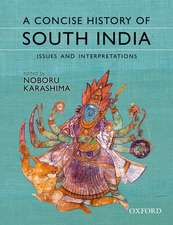The Indian Army, 1939-47: Experience and Development
Autor Patrick Rose Editat de Alan Jeffreysen Limba Engleză Hardback – 28 iun 2012
| Toate formatele și edițiile | Preț | Express |
|---|---|---|
| Paperback (1) | 416.22 lei 6-8 săpt. | |
| Taylor & Francis – 24 mai 2017 | 416.22 lei 6-8 săpt. | |
| Hardback (1) | 1114.70 lei 6-8 săpt. | |
| Taylor & Francis – 28 iun 2012 | 1114.70 lei 6-8 săpt. |
Preț: 1114.70 lei
Preț vechi: 1359.39 lei
-18% Nou
Puncte Express: 1672
Preț estimativ în valută:
213.33€ • 221.89$ • 176.11£
213.33€ • 221.89$ • 176.11£
Carte tipărită la comandă
Livrare economică 14-28 aprilie
Preluare comenzi: 021 569.72.76
Specificații
ISBN-13: 9781409435532
ISBN-10: 1409435539
Pagini: 256
Dimensiuni: 156 x 234 x 16 mm
Greutate: 0.61 kg
Ediția:1
Editura: Taylor & Francis
Colecția Routledge
Locul publicării:Oxford, United Kingdom
ISBN-10: 1409435539
Pagini: 256
Dimensiuni: 156 x 234 x 16 mm
Greutate: 0.61 kg
Ediția:1
Editura: Taylor & Francis
Colecția Routledge
Locul publicării:Oxford, United Kingdom
Cuprins
Contents: Foreword, Sir John Chapple; Introduction; The evolution and use of British imperial military formations, Ashley Jackson; Indian Army command culture and the North West Frontier, 1919-1939, Patrick Rose; Did Winston matter? Churchill and the Indian Army, 1940-1945, Raymond Callahan; Training the Indian Army, 1939-1945, Alan Jeffreys; The Battle of Wadi Akarit, 6 April 1943; 4th Indian Division and its place in 8th Army, Chris Mann; 'Debunking the bunker': from Donbaik to Razabil, January 1943-March 1944, Tim Moreman; The re-capture of Rangoon, 1945: the last and greatest victory of the British Indian Army, Graham Dunlop; The 20th Indian Division in French Indo-China, Daniel Marston; Re-forging the Damascus blade: partition of the Indian Armoured Corps, 1947, Ashok Nath; A dismal story? Britain, the Gurkhas and the partition of India, 1945-1948, David Omissi; Small wars and internal security: the Army in India, 1936-1946, Robert Johnson; Index.
Notă biografică
Patrick Rose received a PhD in War Studies from King’s College London for a thesis examining command culture in the British and Indian Armies between 1919 and 1945. He is a West Point Fellow in military history, and co-editor and contributing author of the forthcoming book Allied Fighting Effectiveness in North Africa and Italy, 1942-1945. He is currently a senior analyst in the Defence Science and Technology Laboratory of the UK Ministry of Defence. A member of the Defence Policy Analysis Group, he has recently deployed to support NATO campaign planning in Afghanistan. Alan Jeffreys is Senior Curator, Social History at the Imperial War Museum. He is the author of The British Army in the Far East, 1941-45 (2005) and Training the Indian Army, 1939-45 (Ashgate, forthcoming). He is also co-editor of an academic history series entitled 'India at War'.
Recenzii
’... this collection of papers is invaluable in understanding how the Indian Army operated during the Second World War. It is easy to forget that its cream was initially deployed to North Africa and that the troops sent to Malaya and Singapore, and in the Arakan to an extent, were ill trained and hardly ready for combat... Yet, within a year of the Arakan disasters it was transformed into a first class fighting machine that repulsed the final major Japanese offensive in Burma and went on to drive them out of the country. It stood up well to the challenges of the immediate post-war years and maintained its good order and discipline through Partition and beyond. These papers show how all this was achieved and their authors are to be much congratulated.’ Mars & Clio: the journal of the British Commission for Military History 'The Indian Army, 1939-47 is an excellent book which is a must-read for historians of the Second World War and the British Empire. It also contains much food for thought for those concerned with doctrine, training and military culture. It deserves a wider readership than just its core audience.' RUSI Journal 'This book is a very readable outcome of an inspiring conference and lays the groundwork for further research. It should be read by anyone with a serious interest in the role of the Indian Army in the Second World War. Highly recommended. DURBAR, Journal of the Indian Military Historical Society 'Over a number of important and extremely interesting chapters, this book offers a snapshot on how the Indian Army worked within and then emerged from an Imperial system of security.' Second World War Military Operation Research Group
Descriere
This volume examines the Indian Army between the outbreak of war in 1939 and the partition of India in 1947. With contributions from many of those at the forefront of the study of the Indian Army and Commonwealth history, the book makes a substantial contribution to a range of subjects, from the Indian Army's participation in the Second World War, to the evolution of wartime training, frontier operations, and its role in the development of post-war counterinsurgency practice. The volume concludes with several chapters examining the impact and legacy of Partition in 1947.






